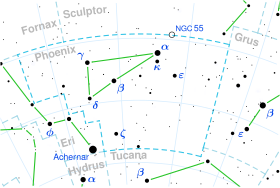
Summary
HD 222095 is a single[10] star in the southern constellation of Phoenix, near the western constellation border with Grus. It has a white hue and is visible to the naked eye with an apparent visual magnitude of 4.74.[2] The star is located at a distance of is approximately 200 light years based on parallax,[1] and it is drifting further away with a radial velocity of +3.4 km/s.[4]
| Observation data Epoch J2000 Equinox J2000 | |
|---|---|
| Constellation | Phoenix |
| Right ascension | 23h 37m 50.99418s[1] |
| Declination | −45° 29′ 32.4672″[1] |
| Apparent magnitude (V) | 4.74[2] |
| Characteristics | |
| Evolutionary stage | main sequence |
| Spectral type | A1/2V[3] |
| U−B color index | +0.09[2] |
| B−V color index | +0.08[2] |
| Astrometry | |
| Radial velocity (Rv) | +3.40[4] km/s |
| Proper motion (μ) | RA: +70.71[1] mas/yr Dec.: −12.66[1] mas/yr |
| Parallax (π) | 16.29 ± 0.22 mas[1] |
| Distance | 200 ± 3 ly (61.4 ± 0.8 pc) |
| Absolute magnitude (MV) | 0.80[5] |
| Details | |
| Mass | 2.55[6] M☉ |
| Radius | 2.2[7] R☉ |
| Luminosity | 41.42[5] L☉ |
| Surface gravity (log g) | 3.92[6] cgs |
| Temperature | 9,230[6] K |
| Metallicity [Fe/H] | −0.01[8] dex |
| Rotational velocity (v sin i) | 141[6] km/s |
| Age | 482[6] Myr |
| Other designations | |
| Database references | |
| SIMBAD | data |
This object is an A-type main-sequence star with a stellar classification of A1/2V.[3] It has a high rate of spin with a projected rotational velocity of 141[6] to 165 km/s, giving it an equatorial bulge that is 4% larger than the polar radius.[11] The star is 482 million years old with 2.55[6] times the mass of the Sun and around 2.2[7] times the Sun's radius. It is radiating 41[5] times the luminosity of the Sun from its photosphere at an effective temperature of 9,230 K.[6] The chemical abundance of the star's outer atmosphere is similar to that in the Sun.[8]
References edit
- ^ a b c d e f Van Leeuwen, F. (2007). "Validation of the new Hipparcos reduction". Astronomy and Astrophysics. 474 (2): 653–664. arXiv:0708.1752. Bibcode:2007A&A...474..653V. doi:10.1051/0004-6361:20078357. S2CID 18759600. Vizier catalog entry
- ^ a b c d Ducati, J. R. (2002). "VizieR Online Data Catalog: Catalogue of Stellar Photometry in Johnson's 11-color system". CDS/ADC Collection of Electronic Catalogues. 2237. Bibcode:2002yCat.2237....0D.
- ^ a b Houk, Nancy (1978). Michigan catalogue of two-dimensional spectral types for the HD stars. Vol. 2. Ann Arbor: Dept. of Astronomy, University of Michigan. Bibcode:1978mcts.book.....H.
- ^ a b Gontcharov, G. A. (2006). "Pulkovo Compilation of Radial Velocities for 35 495 Hipparcos stars in a common system". Astronomy Letters. 32 (11): 759–771. arXiv:1606.08053. Bibcode:2006AstL...32..759G. doi:10.1134/S1063773706110065. S2CID 119231169.
- ^ a b c Anderson, E.; Francis, Ch. (2012). "XHIP: An extended hipparcos compilation". Astronomy Letters. 38 (5): 331. arXiv:1108.4971. Bibcode:2012AstL...38..331A. doi:10.1134/S1063773712050015. S2CID 119257644. Vizier catalog entry
- ^ a b c d e f g h David, Trevor J.; Hillenbrand, Lynne A. (2015). "The Ages of Early-Type Stars: Strömgren Photometric Methods Calibrated, Validated, Tested, and Applied to Hosts and Prospective Hosts of Directly Imaged Exoplanets". The Astrophysical Journal. 804 (2): 146. arXiv:1501.03154. Bibcode:2015ApJ...804..146D. doi:10.1088/0004-637X/804/2/146. S2CID 33401607. Vizier catalog entry
- ^ a b Pasinetti Fracassini, L. E.; et al. (February 2001), "Catalogue of Apparent Diameters and Absolute Radii of Stars (CADARS)", Astronomy and Astrophysics, 367 (2) (Third ed.): 521–524, arXiv:astro-ph/0012289, Bibcode:2001A&A...367..521P, doi:10.1051/0004-6361:20000451, S2CID 425754
- ^ a b Gontcharov, G. A. (2012). "Dependence of kinematics on the age of stars in the solar neighborhood". Astronomy Letters. 38 (12): 771–782. arXiv:1606.08814. Bibcode:2012AstL...38..771G. doi:10.1134/S1063773712120031. S2CID 118345778. Vizier catalog entry
- ^ "HD 222095". SIMBAD. Centre de données astronomiques de Strasbourg. Retrieved 2019-11-19.
- ^ Eggleton, P. P.; Tokovinin, A. A. (2008). "A catalogue of multiplicity among bright stellar systems". Monthly Notices of the Royal Astronomical Society. 389 (2): 869. arXiv:0806.2878. Bibcode:2008MNRAS.389..869E. doi:10.1111/j.1365-2966.2008.13596.x. S2CID 14878976.
- ^ van Belle, Gerard T. (March 2012). "Interferometric observations of rapidly rotating stars". The Astronomy and Astrophysics Review. 20 (1): 51. arXiv:1204.2572. Bibcode:2012A&ARv..20...51V. doi:10.1007/s00159-012-0051-2. S2CID 119273474.



